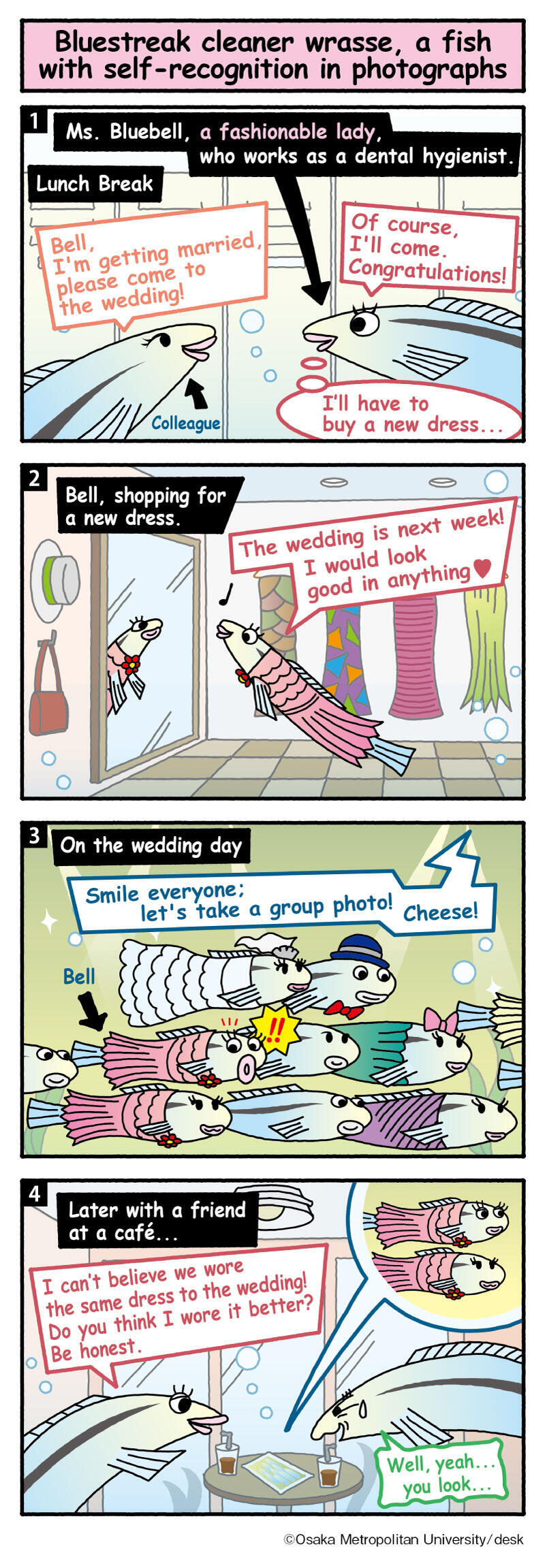When you look in the mirror, what do you see? There can be many answers to this question, which may also change over time – but the basic, most obvious response is: you see yourself. You see your reflection, your face gazing back at you. This truth is so evident that it goes without saying. From the earliest moments we could form memories, gazing into a mirror always brought the clear understanding that we were seeing our own selves.
However, this was not always the case. As one-year-old infants, when our parents held us in front of a mirror, we did not comprehend that we were observing ourselves. It wasn't until around eighteen months of age that we began to grasp that the reflection was not that of another baby. This marks an important milestone in the development of our self-awareness, the understanding of one’s “self”, both physically and mentally.
Do animals also have such awareness? What do they see when they look in a mirror? Do they know who their “self” is and understand how it differs from “others”?
The Classical Test
The first scientist who set out to scientifically examine these questions was Gordon Gallup. His approach was both simple and ingenious: how can we determine if a certain animal recognizes that the reflection it sees in the mirror is indeed itself? We will distinctly mark its forehead and position it in front of a mirror. If the animal comprehends that the image in the mirror represents itself, it will also recognize the marked spot on its forehead, attempting to touch or remove it. Conversely, if it perceives the reflection as another animal, it will not exhibit such behavior.
Naturally, several considerations must be taken into account, to exclude alternative explanations for the animal’s behavior. The marking process should occur while the animals are sleeping, to prevent them from noticing it consciously; some subjects should wear a transparent mark, to ensure that the subjects are not merely sensing or smelling the marker and therefore touching it out of awareness. Additionally, their behavior should be assessed both in front of a mirror and without one to confirm consistency, rather than solely observing their behavior in front of a mirror.
Gallup conducted the first mirror test with chimpanzees, demonstrating that they indeed are capable of recognizing themselves. Orangutans also demonstrated this ability, while gorillas largely did not. Numerous studies were conducted on various monkey species, and almost all of them failed to recognize themselves. In contrast, certain marine mammals, including bottlenose dolphins (Tursiops truncatus) and orcas (Orcinus orca), successfully passed the test, as did various avian species, such as the Eurasian Magpie (Pica Pica). However, many other species, including dogs, panda bears and parrots, failed to exhibit self-recognition. In 2019 the Bluestreak Cleaner Wrasse became the first fish to enter the respectable club of self-recognition. These fish were marked with a brown dot on their necks, and when presented with a mirror they exhibited behavior suggesting self-recognition, as they attempted to remove the perceived “stain” by rubbing their against the aquarium floor.
(A video depicting fish observing themselves in a mirror and engaging in self-directed behavior)
Who Is The Test Fitted For?
Almost from the moment of its inception the Mirror Test has sparked significant controversy and debate, which has only intensified over the years - in part due to the diverse groups of animals that have managed to pass the test compared to those that have not - enhancing the debate regarding the Test’s applicability and what it truly measures across different species. If fish can pass the test but monkeys cannot, what does that even mean? Gallup claimed that his findings demonstrated that chimpanzees have self-awareness. Should we surmise from this that magpies are self-aware while dogs are not? And what about cases when some individuals of a species pass the test and others do not, as seen, for example, with elephants? Does this mean that only some elephants are self-aware, while others are not?
One of the main problems with the test is that it fits a very certain type of animals: those that rely primarily on sight, tend to notice marks or stains on themselves and take care of them, and have the limbs that allow them to do so. In other words, the test fits us, humans, and also primates that highly resemble us. But what about dogs, for example, who navigate the world using largely their sense of smell rather than their sight? Their difficulty in recognizing the dog in the mirror might stem from the fact that it lacks smell and also does not make sounds like a regular dog. Other animals simply do not care too much about marks on their skin, and even if they realize through the mirror that they have a paint mark on their forehead, they may not necessarily rush to remove it. "The mark test can be difficult to apply across species because it assumes that a particular animal will be interested in something weird on their body," stated elephant researcher Joshua Plotnik in an interview for Scientific American. “Primates are interested in such things—we're groomers. But elephants are different. They're huge and they're used to putting things on, not taking things off of their bodies, like mud and dirt". In short, the classic test does not take into account the different characteristics of animals and their behaviors.
The extensive criticism of the test has been ongoing for many years, prompting researchers to seek alternative solutions. Recently, several studies were published, proposing different methods to advance the research of animal self-recognition. ONe study introduced a test tailored to better suit the natural behaviors of the examined animals. Another study delved into assessing whether the animals that have passed the test possess a genuine mental representation of their own appearance; and a third study aimed to elucidate the fundamental brain mechanisms underlying self-recognition.
5 View gallery
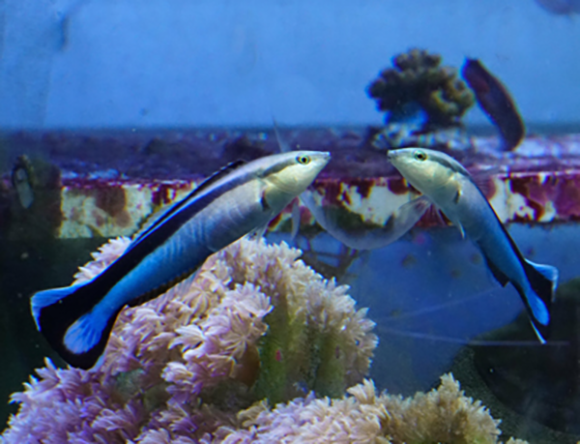

The fish were marked with a brown dot on their necks, and when presented with a mirror they began rubbing their necks on the aquarium floor, potentially in an attempt to remove the 'stain' Bluestreak Cleaner Wrasse fish
(Photo: Masanori Kohda, Osaka City University)
For Whom Does The Rooster Call?
In a recent research article published in October, researchers from Germany endeavored to explore alternative methods to assess animals’ ability to recognize themselves in the mirror, with a focus on roosters. When subjected to the classic test, roosters failed to interact with the painted marks placed right under their beaks, upon seeing themselves in the mirror. However the researchers hypothesized that this failure may be caused by the fact that they are unaccustomed to touching their face with their feet - they almost always use their beaks to groom and clean themselves, which was not possible in this case. To know whether roosters are truly able to recognize themselves in the mirror, the researchers argued, they needed to be tested in a way that is more suited to their natural behavior.
For this purpose they used a well-known trait of roosters: they call out loudly to warn their companions when they see a predator approaching. The calls may also attract the predator’s attention, and perhaps for this reason, when they are alone, they do not make a sound. The researchers placed each of the roosters in a cage that was divided in two - in some cases, another rooster was in the other half of the cage, behind a transparent divider; in some cases the rooster was alone; the transparent divider was replaced with a mirror. The researchers then projected the shadow of a hawk on the ceiling above the rooster, "flying" from one side of the cage to the other. When the roosters saw their companion on the other side of the divider, they almost always called out loudly. When they were alone, they almost never called out. And when they saw their own reflection? In this case, they remained silent, just as they did when they were alone. This means they did not regard their reflection as a different rooster - which could suggest that they understand it is their own reflection.
5 View gallery
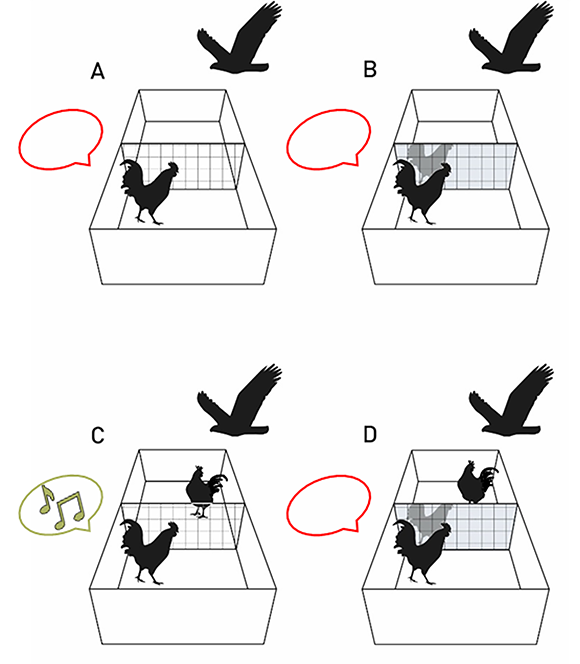

The adapted test procedure in roosters: A rooster tested alone (A), a rooster tested with a mirror (B), a rooster tested seeing another rooster in the adjacent cell (C), and a rooster tested with a mirror that hides another rooster in the adjacent cell (D). Only in case C did the rooster call out a warning
(Photo: Sonja Hillemacher et al.)
Self Awareness Or Mere Confusion?
These findings could be seen as supporting the existence of self-awareness in roosters, “However, these results will not be enough to persuade all scientists.”, stated Masanori Kohda, who led the study conducted on Wrasse fish but was not involved in the current study, in an interview to the New York Times. One reason for skepticism is that while the researchers demonstrated that roosters do not perceive their own reflection as a distinct individual, they did not elucidate what the roosters did perceive it to be. It is possible that they understand that it is merely a reflection and it is also possible that they do not perceive it as a rooster or an animal at all.
This alternative test, then, is certainly not perfect. However, quite a few researchers believe that the path forward should involve the development of additional tests of this type, which take into account the natural behavior of animals and their capabilities. Studies that will make use of such tests, says Kohda, will lead to a more correct assessment of animals' self-recognition and self-awareness abilities. “The original mark test exactly delays the progress of understanding animal-mind.”, he claimed.
5 View gallery
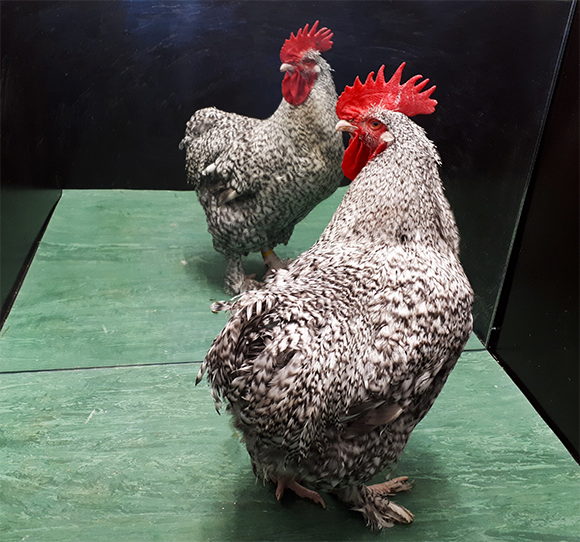

A rooster passed a mirror test that was adapted to its natural behavior. A rooster in front of a mirror
(Photo: Sonja Hillemacher)
Who Is Seen In the Image?
Other studies have focused on trying to understand exactly what the mirror test indicates. When an animal touches the mark on its forehead in front of the mirror, is it looking at the reflection and thinking “this is me”? Can it remember the face it sees and link it with its own identity, or does it simply understand that the animal it sees is moving like it and therefore represents itself?
It is difficult to answer these questions without having direct access to the animals’ thoughts. One approach to attempt to do so involves testing whether animals are able to recognize a photo of themselves. A recently published study, conducted with bluestreak cleaner Wrasse fish, attempted to do just that. These fish typically exhibit aggressive behavior towards unfamiliar fish that enter their territory, and the researchers examined whether their response differed when confronted with a photo of an unfamiliar fish compared to an image of themselves.
The findings of this study showed that while the fish attack the photo of the unfamiliar fish, swimming quickly towards it and attempting to bite it, they do not behave in the same manner towards photos of themselves - but only if they have previously experienced mirrors. Fish that had never seen a mirror before treated the photo as if it were an unfamiliar fish, while fish that had undergone the mirror test understood, apparently, that the fish in the photo was themselves. Furthermore: if the fish in the image had a mark on its neck, they rubbed themselves against the ground, probably thinking that they see themselves and therefore they also have such a mark. When presented with a photo of a foreign fish with a mark they did not react in the same manner.
Thus, the fish recognize themselves not only in the mirror but also in the image. This means that they not only understand that the fish in the mirror is a reflection, for example, because it moves exactly like them, but they also remember how it - meaning they - look. They store in their brain an image labeled as "myself," just like humans do.
“This study is the first to demonstrate that fish have an internal sense of ‘self’.”, said Khoda, who also led this study, in a press release. Since the target animal is a fish, this finding suggests that nearly all social vertebrates also have this higher sense of self,”.
The problem with this statement, of course, is that many social vertebrates, from monkeys to dogs, did not pass the mirror test. This reinforces the hypothesis that the fault is in the test itself, and not in the self-recognition ability of the animals.
Mice In The Mirror
In another study, published in early December, researchers sought not only to test whether certain animals - in this case, mice - can recognize themselves in the mirror, but also to understand the brain mechanisms that underlie this ability. They used the classic mirror test, and marked the foreheads of black mice with a black or a white mark, while they slept. The mice with the much more visible white mark did clean themselves upon seeing their reflection in the mirror - but only in cases when the mark on their forehead was relatively large - at least 0.6 square centimeter. Smaller marks, which were still very visible to us, did not lead to this behavior. Additionally, the researchers found that the mice required prior knowledge of a mirror before they could use it. When the researchers placed a mirror in their cage a few days prior to the test, it appeared that they noticed the white mark on their own forehead and cleaned it. However, if this was the first time they encountered a mirror, they did not do the same.
Another crucial factor in the mice’s ability to recognize themselves is their social experience. Mice raised in isolation, as well as black mice reared by white female mice, failed to use the mirror properly. It appears that there is a link between the mice’s ability to recognize themselves and exposure to mice that look like them.
(A video from the study that shows the mice with the white mark on their heads looking in the mirror)
Hippocampus For Self Recognition
The next step for the researchers was to determine which areas in the brain are involved in self-recognition. They found multiple regions, including the prefrontal cortex and the hippocampus, which were active during the test. The researchers decided to focus on the hippocampus, a brain structure involved in the processes of learning, memory and the processing of sensory information, which past studies have also found to play a role in human facial recognition.
Using genetic engineering, the researchers temporarily disabled the activity of certain nerve cells in the hippocampus, and found that mice that were inhibited for the activity of these cells did not clean themselves when the white mark was placed on them - a clear indication of their inability to recognize themselves in the mirror. The activity of this cell population in the hippocampus, the researchers concluded, is essential for self-recognition.
However, these cells do more than this. "A subset of these self-responding neurons was also reactivated when we exposed the mice to other individuals of the same strain," said Takashi Kitamura, the lead researcher and corresponding author of the paper, in a press release. "This is consistent with previous human literature that showed that some hippocampal cells fire not only when the person is looking at themselves, but also when they look at familiar people like a parent." These cells were not activated in mice that were raised in isolation - suggesting a link between social experience and the ability to use a mirror.
5 View gallery
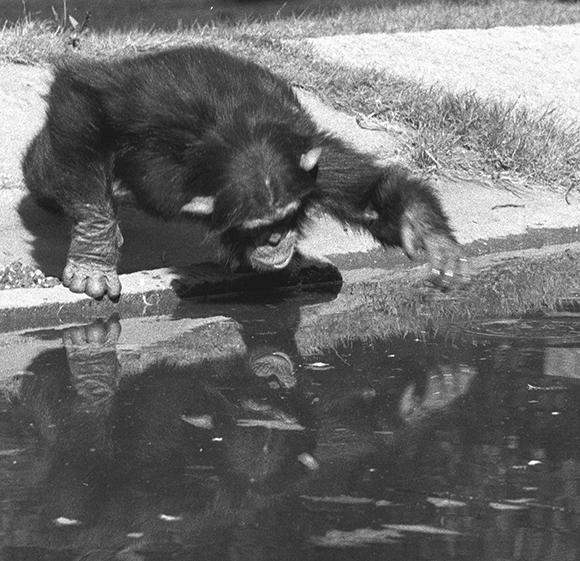

Quickly grasp the concept of a mirror. A chimpanzee looking at its reflection in the water
(Photo: Frans de Waal)
Unveiling Layers Of Self Awareness
The findings of the study could begin to explain how and with the help of which brain structures animals recognize themselves. Additionally, they reveal that mice require certain conditions to recognize themselves in the mirror: only when they have a relatively large color mark, which they can also sense, are they able to do so successfully. “We have to put a lot of ink on their heads, and then the tactile stimulus coming from the ink somehow enables the animal to detect the ink on their heads via a mirror reflection,” said Jun Yokose, who headed the study, in a press release. “Chimps and humans don't need any of that extra sensory stimulus” he added.
Yokose was not the first to point out that animals that pass the mirror test may do so in different ways. Chimpanzees, for example, quickly grasp the concept of a mirror and use it - they spend a lot of time in front of it and use it to see parts of their bodies that they were unable to see without it. Primatologist Frans De Waal said that on sunny days, chimpanzees he works with use his sunglasses as mirrors. “While staring into them, they inspect the inside of their mouth, opening it wide to feel their teeth with a finger while coordinating closely with their reflection.” he wrote in an article published in 2019. “They may also turn around to inspect an injury on their back”. Other animals, even those that passed the mirror test, did not display such behaviors.
On the other hand, dogs cannot pass the mirror test, but many dog owners could confirm that they learn quickly that the dog in the mirror is not a stranger and is not trying to attack it nor play. Studies have shown that monkeys and parrots, which are also unable to pass the classic test, can use mirrors in a different manner, to locate concealed food items.
One of the main criticisms of the mirror test is that it cannot reflect all these nuances, as its results are binary: either the animal passes the test, or it does not. “What if self-awareness develops like an onion, growing layer by layer, rather than appearing out of nowhere?” asked de Waal. This seems to be the case with infants, who start to show interest in mirrors long before they realize that what they are looking at is their own reflection.
De Waal, much like other researchers, calls to approach self recognition and self awareness in a more gradual manner. “We need a much larger test battery, including nonvisual tasks, to develop a full understanding of how other species perceive themselves and position themselves in the world,” he concluded. The studies reviewed in this article, and many more like them, try to add on the classic test and develop novel approaches for exploring animal self-awareness, beyond mere mirror reflections.


